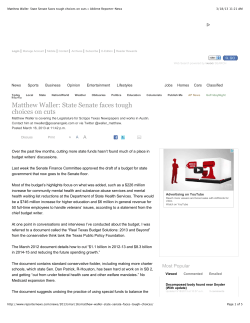
Last but not least
Perception, 2005, volume 34, pages 1417 ^ 1420 DOI:10.1068/p5398 Last but not least Homage to Peter Thompson: The Tony Blair illusion In 1980 Peter Thompson published his celebrated paper on the Thatcher illusion, which became one of the most frequently cited papers ever published in Perception. In homage to Peter Thompson, and to mark the quarter-centenary of his efforts, I propose here a Tony Blair illusion (figure 1). We are adept at recognizing faces, but our skills fail when faces are inverted (presented upside down). This failure is thought to be due to disruption of configural processing. Thompson inverted just the eyes and mouth in a portrait of Mrs Thatcher, which produced a grotesque effect. However, when a normal and `thatcherized' face were both inverted, the perceptual differences between them vanished and they both looked fairly normal. Thompson's web page at http://www-users.york.ac.uk/pt2/ shows his own face, which looks marginally more grotesque when thatcherized. Michael Bach has a Quicktime movie of Mrs Thatcher's face slowly rotating, on his web page at http://www.michaelbach.de/ot/. Thompson's remarkable illusion suggests that decoding of facial expression seems to work best in the same orientation in which faces are seen most of the time. Even 6-month-old babies (Bertin and Bhatt 2004) and autistic children (Rouse et al 2004) are susceptible to the Thatcher illusion. In fact Lewis (2003) found no effect of age among people aged between 6 and 75 years; young children showed the same effects as adults. Similarly, Itier and Taylor (2004) found inversion and contrast-reversal effects in all their child and adult subjects, but these did not increase with age, suggesting no increased reliance on configural processing over the life span. Itier and Taylor (2002) found that negative and inverted faces affected both early (encoding) and late (recognition) stages of face processing, although to different extents. Boutsen and Humphreys (2003) investigated the contribution of local and global processing to the Thatcher illusion in normal observers and concluded that (i) face inversion disrupts local configural processing, but not the processing of image features, and (ii) thatcherization disrupts local configural processing in upright faces. The Thatcher illusion demonstrates that inversion is especially detrimental to the processing of faces. Bartlett and Searcy (1993) attributed this detriment to a loss of holistic or configural processing for inverted faces. Sturzel and Spillmann (2000) suggest that this loss of configural processing occurs suddenly as a face is rotated slowly from upright to inverted, but Lewis (2001) found a gradual loss of configural information during rotation, rather than a rapid switch from one type of processing to another. The fact that inverted faces are so hard to recognize has led to the common assumption that configural cues strongly influence the recognition of upright, but not inverted, faces. However, Sekuler et al (2004) disagree, finding that processing of upright and inverted faces differs quantitatively, not qualitatively; information is extracted more efficiently from upright faces, perhaps as a by-product of orientation-dependent expertise. Faces are also very hard to recognize when they are contrast-reversed (presented in photographic negative). It is known that processing of shading information in face recognition is susceptible to bottom lighting and contrast reversal, an effect that may be due to a disruption of 3-D shape processing. Liu et al (2000) asked whether the disruption can be rectified by 3-D information from shape-from-stereo. They compared identification performance either with or without stereo information using top-lit and 1418 Last but not least bottom-lit face stimuli in both photographic positive and negative conditions. They found that stereo information did not reduce any of the shading effects, so shape-fromshading overrode shape-from-stereo in face perception. They concluded that face perception is based much more upon 2-D than 3-D shape processing. Perrett et al (1984) measured the responses of face-selective cells in the macaque temporal lobe, and found that visual transformations that make it difficult for humans to perceive faces (eg contrast reversal, isoluminant colour, coarsely quantized images, rotation, or inversion) reduced the magnitude or increased the latency of cell responses to faces. Thus cell responses were related to perception and not simply to visual qualities of the image. I wore contrast-reversing video goggles for three days and noted that faces were very hard to recognize in negative, and there was little improvement over the course of three days (Anstis 1992). Surprisingly, emotional expressions were much easier to read in negative than were facial identities; it was possible to recognize that a person's face was surprised, angry, etc without recognizing whose face it was. Figure 1. (a) Unretouched negative photograph of Tony Blair. This is analogous to an upsidedown face. (b) Face is negative except for the eyes, teeth, and hair, which are positive. This is equivalent to an upside-down thatcherized face, but looks barely more grotesque than (a). (c) Reversing the contrast of (a) yields a normal photo. (d) Reversing the contrast of (b) yields a grotesque portrait, with the whole face positive except for the negative eyes, hair, and teeth. This is equivalent to an erect thatcherized face. Last but not least 1419 I have done for negative faces what Thompson did for inverted faces. Figure 1a is a contrast-reversed portrait of Mrs Thatcher's latest successor, the much-loved Tony Blair, well-known for his gleaming eyes and teeth. Next to it is a modified negative (figure 1b), which looks similar to, or perhaps more lifelike than, 1a. In fact, the mouth, eyes, and hair in figure 1b were individually contrast-reversed before the whole picture was contrast-reversed, so these features are positive whilst the rest of the face is negative. This is analogous to thatcherizing the face in the contrast domain. When these two pictures are viewed in positive, figure 1c is clearly normal, whereas the grotesqueness of figure 1d is vampirish enough to scare little Tory children. Thompson introduced highly visible distortion by inverting local features of a face, and found that these distortions became invisible when the whole face was inverted, perhaps owing to a failure in configural processing. The same distortions in the contrast domain seem to be highly visible when they are applied to a positive picture (figure 1d) but become invisible when the whole picture is contrast-reversed (figure 1b), suggesting that the breakdowns discovered by Thompson in the positional domain also exist in the contrast domain. This implies that inverted and contrast-reversed portraits pose some similar difficulties to the visual system. Lewis and Johnston (1997) found that the Thatcher illusion occurs, in albeit a reduced form, when photographic negatives are used. This would suggest that there are similarities between the Blair illusion and the Thatcher illusion (in much the same way as there are similarities between Blair and Thatcher). Stuart Anstis Department of Psychology, University of California at San Diego, 9500 Gilman Drive, La Jolla, CA 92093-0109, USA; e-mail: sanstis@ucsd.edu; website: http://www.psy.ucsd.edu/sanstis Acknowledgments. Supported by grants from the Department of Psychology and Academic Senate, University of California at San Diego. This work was carried out during a summer Sabbatical in Oxford. I thank Professors Oliver Braddick and Brian Rogers for providing facilities in the Department of Psychology, Oxford; and the Master and Fellows of Pembroke College, Oxford, for electing me to a Visiting Fellowship. References Anstis S M, 1992 ``Visual adaptation to a negative, brightness-reversed world: Some preliminary observations'', in Neural Networks for Vision and Image Processing Eds G A Carpenter, S Grossberg (Cambridge, MA: MIT Press) pp 1 ^ 14 Bartlett J C, Searcy J, 1993 ``Inversion and configuration of faces'' Cognitive Psychology 25 281 ^ 316 Bertin E, Bhatt R S, 2004 ``The Thatcher illusion and face processing in infancy'' Developmental Science 7 431 ^ 436 Boutsen L, Humphreys G W, 2003 ``The effect of inversion of the encoding of normal and `thatcherized' faces'' Quarterly Journal of Experimental Psychology A 56 955 ^ 975 Itier R J, Taylor M J, 2002 ``Inversion and contrast polarity reversal affect both encoding and recognition processes of unfamiliar faces: a repetition study using ERPs'' NeuroImage 15 353 ^ 372 Itier R J, Taylor M J, 2004 ``Face inversion and contrast-reversal effects across development: in contrast to the expertise theory'' Developmental Science 7 246 ^ 260 Lewis M B, 2001 ``The lady's not for turning: rotation of the Thatcher illusion'' Perception 30 769 ^ 774 Lewis M B, 2003 ``Thatcher's children: development and the Thatcher illusion'' Perception 32 1415 ^ 1421 Lewis M B, Johnston R A, 1997 ``The Thatcher illusion as a test of configural disruption'' Perception 26 225 ^ 227 Liu C H, Collin C A, Chaudhuri A, 2000 ``Does face recognition rely on encoding of 3-D surface? Examining the role of shape-from-shading and shape-from-stereo'' Perception 29 729 ^ 743 Perrett D I, Smith P A, Potter D D, Mistlin A J, Head A S, Milner A D, Jeeves M A, 1984 ``Neurones responsive to faces in the temporal cortex: studies of functional organization, sensitivity to identity and relation to perception'' Human Neurobiology 3 197 ^ 208 Rouse H, Donnelly N, Hadwin J A, Brown T, 2004 ``Do children with autism perceive secondorder relational features? The case of the Thatcher illusion'' Journal of Child Psychology and Psychiatry 45 1246 ^ 1257 1420 Last but not least Sekuler A B, Gaspar C M, Gold J M, Bennett P J, 2004 ``Inversion leads to quantitative, not qualitative, changes in face processing'' Current Biology 14 391 ^ 396 Sturzel F, Spillmann L, 2000 ``Thatcher illusion: dependence on angle of rotation'' Perception 29 937 ^ 942 Thompson P, 1980 ``Margaret Thatcher: a new illusion'' Perception 9 483 ^ 484 ß 2005 a Pion publication N:/psfiles/banners/ web-cr.3d ISSN 0301-0066 (print) ISSN 1468-4233 (electronic) www.perceptionweb.com Conditions of use. This article may be downloaded from the Perception website for personal research by members of subscribing organisations. Authors are entitled to distribute their own article (in printed form or by e-mail) to up to 50 people. This PDF may not be placed on any website (or other online distribution system) without permission of the publisher.
© Copyright 2025





















